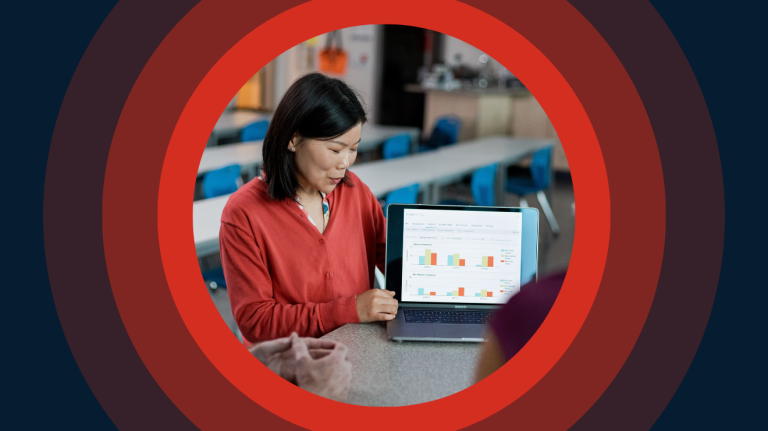Your Ultimate Introductory Guide to Digital Literacy
In our ever-evolving digital age, digital literacy is increasingly becoming a topic of intense conversation and even debate in educational circles. But what exactly is it, and why should you care about it?
In a society where technology is more than just a tool — it's now a way of life — being comfortable and confident with technology is pivotal. But is it the role of educators to actively teach digital literacy skills? And if so, what's the best way to go about it?
Here we answer these questions and more and ready you to empower your students with the digital skills they need for the world of tomorrow.
Decoding a digital literacy definition
A common misconception is that digital literacy is just a technical skill. So, before we go any further, let's define what digital literacy actually is.
An Australian Curriculum review of digital literacy gives the following digital literacy definition:
"Digital literacy encompasses the knowledge and skills students need to: create, manage, communicate and investigate data, information and ideas; solve problems; and work collaboratively at school and in their lives beyond school. Digital literacy involves students: critically identifying and appropriately selecting and using digital devices or systems; learning to make the most of the technologies available to them; adapting to new ways of doing things as technologies evolve; and protecting the safety of themselves and others in digital environments."
If we unpack that, we can understand that digital literacy refers to an individual's ability to find, evaluate, and compose clear information through various digital platforms. It includes the capacity to read and interpret media, reproduce data and images through digital manipulation, and evaluate and apply new knowledge gained from digital environments.
Digital literacy goes beyond the simple ability to use digital tools. It's a vast domain of knowledge, abilities, and attitudes that enable individuals to safely and effectively navigate the increasingly digital world around us. It involves a deeper understanding of the technology itself, the underlying operations, and a critical awareness of the issues surrounding digital technologies such as social interactions, online safety, digital rights, privacy, and the implications of the digital divide.
Digital literacy isn't confined to online activities. It plays a crucial role in everyday life, from understanding artificial intelligence-driven technologies to making sense of the digitalised aspects of education, employment, and social engagement. It's about making connections, participating, and learning in a digital environment.
In essence, digital literacy empowers individuals to understand and use technology responsibly, ethically, and effectively. This is increasingly important in today's world where digital technologies pervade nearly all aspects of life, from work and education to social interaction and entertainment.
Why being technologically literate matters
It’s easy to say digital literacy is important because we live in a digital age, and because it’s been incorporated into the Australian school curriculum and both the New Zealand curriculum and Te Marautanga o Aotearoa, but it’s hard to get excited about improving digital literacy skills if you don’t have a clear understanding of why it really matters. We could write a whole article on just that, but here’s the crux of the topic.
Digital literacy opens up a world of possibilities. It empowers individuals to seek, understand, and use information effectively in various digital formats. It goes beyond simply consuming digital content; it involves creating, communicating, and problem-solving in a digital landscape.
Being digitally literate isn't just about benefiting from the vast opportunities offered by the digital world. It's also about safety and security. Digital literacy arms individuals with the knowledge to identify and avoid potential online threats and scams, protecting themselves and their data in a connected world.
Moreover, digital literacy can play a pivotal role in bridging the digital divide, ensuring equal access to information, resources, and opportunities. The importance of digital literacy extends beyond personal advantage — it's about creating a digitally-inclusive society. Here are just some examples of how a lack of digital literacy can result in significant disadvantages in our society.
With the proliferation of artificially intelligent software, it's become easier than ever to create (very realistic) completely false images and footage that can be used to spread misinformation. It takes a reasonable level of digital literacy to understand such possibilities and then learn to be appropriately skeptical of anything that seems unusual or far-fetched. This has potential serious ramifications in so many areas, but one key example at the time of writing is that deepfakes have been springing up left, right, and centre ahead of the 2024 US presidential election with the goal being to subvert democracy.
Misinformation about COVID-19 has also been, and to some extent still is, prolific across digital channels. Without sufficient digital literacy, it's hard for people to determine which sources of information are reliable, and the consequence of that has been significant vaccine hesitancy in some communities and much unnecessary illness and death. There was also a lot of aggression and even violence directed at health workers from people who believed COVID misinformation.
As another example, scams cost the Australian and New Zealand economies billions of dollars each year. Here is a breakdown of the costs:
Economic costs of scams in Australia:
- Australians lost over $634 million to scams in 2019
- Australians lost a record $3.1 billion to scams in 2022, with most of that money lost to fake investment scams, and the costs of scams to the the Australian economy may have been as much as $4 billion that year
Economic costs of scams in New Zealand
- New Zealanders lost a record $20 million to scammers in 2022
- Scams may cost the New Zealand economy as much as $9.4 billion a year according to a draft Serious Fraud Office (SFO) report
As you can see, low digital literacy can lead to significant negative consequences for individuals and our society as a whole. As the potential for misinformation and digital crime grows, it's paramount that educators take the lead in fighting misinformation through digital literacy education.
Why digital literacy skills should be taught in schools from primary school right up to higher education
Undoubtedly, digital literacy is no longer a luxury, but a necessity in today's hyper-connected world. When digital literacy is deficient, individuals and society at large stand to suffer negative consequences. But who is responsible for battling this tidal wave of misinformation?
Governments and banks have been fighting scams for years. Technology companies have been attempting to help solve the problem of deepfakes with AI and Web3 ID tech. The EU has been urging major platforms to label AI-generated content to help prevent misinformation and deepfakes. And China, the US, and Australia are among the other countries requiring or taking steps to require companies to label AI-generated content.
However, these are, to some extent, bandaid solutions. No matter how strict regulations are around AI content, and no matter how severe penalties are for scams, there will always be people who do the wrong thing. And just as bacteria, viruses, and the immune system are in a constant evolutionary battle, no matter how good technology gets at spotting scams and misinformation, criminals will also continue to improve their dastardly tactics.
So these kinds of activities need to be complemented with education. After all, if we're well educated about the risks, we can practice good password hygiene, avoid falling for scams, and be skeptical about potentially deepfaked content. (Plus tomorrow's tech experts who'll drive innovations in crime-fighting technology need to learn their technical skills from somewhere!)
Schools serve as the first line of defence, equipping students with the necessary skills to navigate the digital world. Educators play an instrumental role in embedding digital literacy in their curriculum, ensuring students can critically assess, use, and produce digital content.
Teaching digital literacy in schools does more than just help students with their schoolwork. It builds competent members of society who can engage constructively in online environments, discern fact from fiction, and protect themselves from digital threats. Furthermore, it encourages active participation in our increasingly digital society, fostering informed decision-making and promoting digital citizenship.
This necessity is why digital literacy must be an integral part of education at all levels, from primary schools to tertiary institutions. By doing so, we ensure the next generation is equipped with the critical skills they need to thrive in the digital age. The importance of digital literacy in education cannot be overstated; it's a tool for empowerment, enabling our society to navigate the digital landscape with confidence and wisdom.
Guiding digital literacy development and teaching digital literacy skills in the classroom
Are you wondering how to implement digital literacy in your classroom? Bringing digital literacy into the learning environment can be a game-changer. It's not merely about incorporating technology; it's about fostering a mindset and a skillset that prepares students for a digital world. Here are some top tips for including digital literacy in your regular teaching program.
Start by integrating digital tools into your lesson plans. This could involve using online resources for research, implementing digital storytelling, or encouraging students to create digital content. By allowing students to interact with digital technology regularly, you're fostering their comfort and proficiency in a digital environment.
While we're implementing digital literacy in education, it's also important to teach students about digital citizenship. This involves teaching them about online safety, privacy, and cyber ethics. Lessons on these topics can help students navigate the digital landscape safely and responsibly.
Creating a collaborative digital learning environment can also enhance digital literacy. Encourage students to engage in online discussions, share resources, and collaborate on digital projects. This not only develops their digital skills but also fosters teamwork and communication skills. If you don't yet have the technology to provide discussion boards and facilitate collaborative digital projects, a learning management system (LMS) like Canvas is a great way to bring all those tools together and integrate them seamlessly into your way of teaching.
When teaching digital literacy, it's important to cater to diverse learning styles. Online learning tools, multimedia presentations, and interactive digital platforms can cater to visual, auditory, and kinesthetic learners, making learning more inclusive and effective.
Lastly, consider providing opportunities for problem-solving using digital tools. This can involve coding exercises, troubleshooting tech issues, or using digital tools to solve real-world problems. Such activities promote critical thinking and problem-solving skills in a digital context.
Remember, implementing digital literacy isn't a one-size-fits-all approach. It should be tailored to the needs of your students and your curriculum. Embrace the challenge, be flexible, and see how digital literacy can transform your teaching and students' learning.
Evaluating digital literacy in students
Assessing digital literacy is a vital component of a comprehensive digital education strategy. But how can you gauge a student's digital literacy? Let's delve into some methods that can help evaluate your students' digital skills and understanding.
One of the first steps in assessing digital literacy is observing how students interact with technology. Watch for their ability to navigate digital tools, their comfort level with different technologies, and how effectively they can find, evaluate and use digital information.
Observations should be continuous and woven into everyday activities to paint an accurate picture of students' digital literacy.
Another approach involves performance-based assessments, where students are asked to complete specific tasks using digital tools. For instance, students could be asked to research a topic online, create a digital presentation, or collaborate on a project using a digital workspace. The key here is to evaluate not just the final product, but also the process they've used to complete the task. A high-quality LMS can make it so much easier for students to perform these kinds of assessments and for educators to assess their performance.
Digital portfolios can also serve as an excellent tool for assessing digital literacy. By compiling a portfolio of digital work, students can demonstrate their digital skills and understanding over time. Portfolios can include a range of digital content, from research projects to multimedia presentations, and can provide a comprehensive view of a student's digital literacy.
Self and peer assessments can also be valuable. Encouraging students to reflect on their own skills, and to provide feedback to their peers, can help them develop a better understanding of digital literacy.
Lastly, don't forget to assess digital citizenship. Understanding how to behave responsibly online is a key part of digital literacy. You can assess this through discussions, quizzes, or by observing students' behaviour in digital environments.
Assessing digital literacy doesn't have to be complex or daunting. By using a combination of these methods, you can evaluate your students' digital literacy effectively. Now, let's wrap up our journey into the world of digital literacy.
Embracing the power of digital literacy
The value of digital literacy in today's education cannot be overstated. Not only does it prepare students for a world where digital technology permeates every aspect of life, but it also equips them with crucial skills for problem-solving, communication, and lifelong learning.
The benefits of digital literacy are far-reaching. By teaching it in schools, we're laying the groundwork for a future generation that's not just full of digital content consumers, but creators and innovators as well. Moreover, it encourages responsible and informed digital citizenship, leading to safer and more effective use of technology. We're also helping to protect future generations from criminal activity and misinformation.
As educators, it's our role to make digital literacy a cornerstone of our teaching. We've explored what digital literacy is, why it's important, and how we can implement and assess it in our classrooms. Now, it's time to put this knowledge into action. Take these insights and strategies, and start your journey towards enhancing digital literacy in your classroom today!
Canvas and Canvas LMS can help with Digital Literacy
Canvas LMS is a full-featured learning management system to serve as the connector and hub of your digital classroom. Its robust tools and integrations engage all learners and save teachers time on desktop or in our much-loved mobile apps for students, parents, and teachers. Some of its key features include a user-friendly interface, standards-based grade books, course content authoring, and more. Institutions can also use Canvas LMS to deliver and scale professional learning opportunities for your staff - so that teachers can continue to grow.
Take teaching, learning, and student engagement to the next level with Canvas LMS, the #1 educational software teachers use and the foundation of the Instructure Learning Platform.
Related Content
 signs_its_time_to_rethink_your_learning_platform.png
signs_its_time_to_rethink_your_learning_platform.pngBlogs
 the_five_essentials_for_vocational_learning_platforms.png
the_five_essentials_for_vocational_learning_platforms.pngBlogs
 from_admin_tool_to_growth_driver.png
from_admin_tool_to_growth_driver.pngBlogs